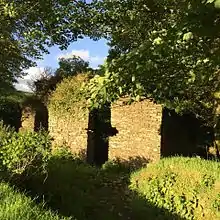Trevalga
Trevalga (Cornish: Trevelgi) is a coastal civil parish and hamlet in north Cornwall, England, United Kingdom. The parish is bounded on the north by the Celtic Sea, on the southeast by Forrabury and Minster parish and on the west by Tintagel parish.
Trevalga
| |
|---|---|
.jpg.webp) St Petroc's Church  Ruins of Trevalga Mill | |
 Trevalga Location within Cornwall | |
| Population | 71 (Civil Parish, 2011) |
| OS grid reference | SX082900 |
| Civil parish |
|
| Shire county | |
| Region | |
| Country | England |
| Sovereign state | United Kingdom |
| Post town | BOSCASTLE |
| Postcode district | PL35 |
| Dialling code | 01840 |
| Police | Devon and Cornwall |
| Fire | Cornwall |
| Ambulance | South Western |
| UK Parliament | |
History and description
The hamlet of Trevalga lies 500 metres from the coast on the seaward side of the road from Boscastle to Tintagel. Unusually, the hamlet is part of an estate held in trust by The Gerald Curgenven Will Trust with profits after maintenance going to Marlborough College, a public school in Wiltshire. The estate has been held in trust since 1961 under a bequest of the last Lord of Trevalga Manor, Gerald Curgenven (died 1959). This was to ensure its preservation from development and allow local families to remain there. However, in 2010, the college was given faulty legal advice that it was actually the owner of the hamlet. As it would be breaking charity law in doing so the College thereafter placed the entire estate on the market. This situation caused understandable concern amongst the tenants, and other inhabitants, about the hamlet's future.[1] Thereafter, protests and petitions were set up, using the social networking website Facebook in an attempt to prevent the sale.[2] The legality of the sale was disputed by the Trustees and Tenants of the estate; then the sale was suspended and the Manor placed back into the hands of the Trustees.[1][3] There were formerly a slate quarry and a silver lead mine in the parish.
Trevalga was one of the manors held by King William at the time of the Domesday Book (1086); it had formerly been held by Queen Matilda and before her by Britric. There were 2 ploughs but land for 8 ploughs; 14 households (including serfs, villeins and smallholders), the livestock was mainly sheep and the pasture was 1 league long and half a league wide. The annual value was £4.[4] The recorded history of the manor continues in the 13th century when it was held by the family of Bassett; in 1601 the Bassetts sold it to the family of Welsh, who were succeeded by the family of Northcote. In 1682 it was bought by William Bolitho of Exeter; upon the death of Richard Bolitho Stephens in 1928 it was inherited by his widow. Mrs. Stephens donated to the church a fine pulpit, reading desk and sanctuary chair, in memory of her late husband.[5]
Trevalga is mentioned in the song Black and Gold along with other places nearby.
Trevalga lies within the Cornwall Area of Outstanding Natural Beauty (AONB).
Notable buildings
The parish church is dedicated to St Petroc; the patrons of the rectory are the dean and chapter of Truro. The earliest recorded rectors are Richard (1173) and Robert Bardolph (1191). The church was built in the 12th and 13th centuries (the tower being later than the nave and chancel). After restoration work the church was reopened in 1875. For many years it has been a member of the Boscastle Group of Anglican parishes.[6][7]
The original manor house of Trevalga is Redevallen in the adjoining parish of Minster. The current building dates from 1642 but is possibly on the site of an earlier building. Writing in 1879, Sir John Maclean describes the principal room being decorated with a moulded cornice, and that it formerly had a fine moulded ceiling. MacLean also records that the walls were pierced for musketry. The house is a grade II listed building.[8]
There is an early Cornish wheel-headed wayside cross in the churchyard.[9] The cross is believed to date from the 8th century. It used to stand by the churchpath but was moved to the churchyard in the early 19th century by the then rector.[10]
At the southeastern corner of the parish of Trevalga is Trevalga Mill, a ruined eighteenth century water mill. The mill lies in fields next to the Trevillet River and is the only one of the four mills on the river (the others are Halgabron, Trevillet and Trethevy) to lie upstream of the waterfall currently known as St Nectan's Kieve. The mill belonged to the nearby manor of Redevallen and would have been used first for grinding corn then perhaps also the making of worsted.[11]
References
- "College plan to sell sparks battle at Trevalga".
- "Log In or Sign Up to View". www.facebook.com.
- "Cornwall's Trevalga Estate sale suspended". BBC. 3 September 2010. Retrieved 12 December 2010.
- Thorn, Caroline, et al. (eds.) (1979) Cornwall (Domesday Book; 10.) Chichester: Phillimore; entry 1,17
- Palmer (1930)
- Pevsner, N. (1970) Cornwall, 2nd ed., edited by Enid Radcliffe. Penguin Books
- Palmer, W. S. Cave (1930) Souvenir of the Parish and Church of Trevalga. Trevalga: [the Author]
- Historic England. "REDEVALLEN, Trevalga (1267261)". National Heritage List for England. Retrieved 26 March 2020.
- Langdon, A. G. (1896) Old Cornish Crosses. Truro: Joseph Pollard; p. 50
- "Trevalga Cross". The Megalithic Portal.
- The "Chapel" Kieve and Gorge of "St Nectan" Trevillet Millcombe, Tintagel; by Sidney J. Madge, Bodmin: Liddell and Son, 1950
External links
| Wikimedia Commons has media related to Trevalga. |